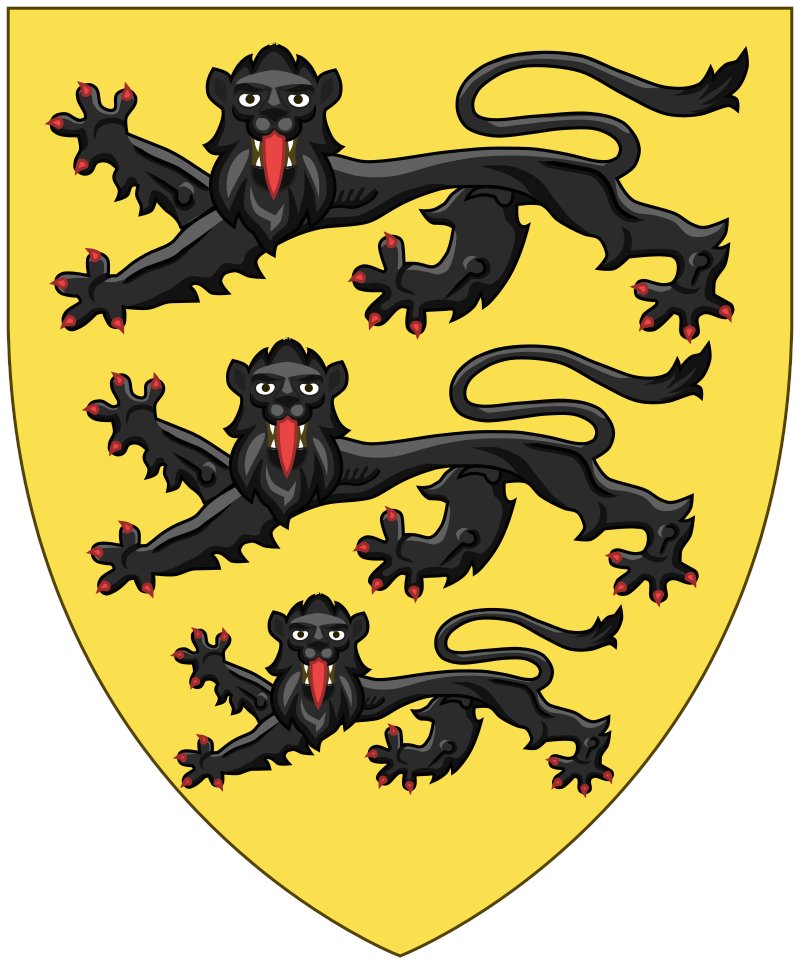Did you know Holy Roman Emperor Frederick II negotiated Jerusalem back to the Christians without a drop of blood being spilled taking the city?
Here is the story of Emperor Frederick II and his endeavors to retake Jerusalem during the Sixth Crusade. 🧵
Here is the story of Emperor Frederick II and his endeavors to retake Jerusalem during the Sixth Crusade. 🧵

After the devastating failure of the Fifth Crusade the only European sovereign in a position to attempt a retaking of Jerusalem was Holy Roman Emperor Frederick II 

In the lands of Syria and Egypt the Ayyubids were engaged in a civil war.
Sultan al-Kamil made an offer during the Fifth Crusade to give territory in exchange for peace in the region. Emperor Frederick would be the man to take advantage.
Sultan al-Kamil made an offer during the Fifth Crusade to give territory in exchange for peace in the region. Emperor Frederick would be the man to take advantage.

When Frederick was crowned King of Germany in 1215 on the 15th of July in Aachen, he immediately took up the cross and called for nobles to do the same.
When he was re-crowned by the Pope in 1220 in Rome on the 22nd of November he took this vow again.
When he was re-crowned by the Pope in 1220 in Rome on the 22nd of November he took this vow again.

The Agreement of San Germano:
On July 25th 1225 in present day Cassino, Italy, the agreement was signed between Frederick II and Honorius III.
This agreement marked Frederick's promise to embark on crusade by the 15th of August 1227 and be on crusade for 2 years.
On July 25th 1225 in present day Cassino, Italy, the agreement was signed between Frederick II and Honorius III.
This agreement marked Frederick's promise to embark on crusade by the 15th of August 1227 and be on crusade for 2 years.

During this period of two years, Frederick promised to maintain 1,000 knights in Syria, provide transport for additional forces, and provide Rome with 100,000 ounces in gold in the care of Hermann of Salza, John of Brienne and the patriarch. 

The funds that were transported would be returned to Emperor Frederick when he arrived in Acre per the agreement.
The agreement also stated that if he did not arrive for any reason including death, the money would be spent on the needs of the Holy Land.
The agreement also stated that if he did not arrive for any reason including death, the money would be spent on the needs of the Holy Land.

Emperor Frederick II committed himself by soul to this endeavor by threat of excommunication from the church if he failed in his side of the agreement.
There was no retreat for Frederick.
There was no retreat for Frederick.

Frederick wanted to go to the Holy Land as the King of Jerusalem, he married Isabella II in 1225 by proxy at Acre. She was crowned days later at Tyre as Queen of Jerusalem.
They became formally married in 1227 in Brindisi on November 9th.
They became formally married in 1227 in Brindisi on November 9th.

In December of 1225, Frederick officially declared himself King of Jerusalem and took the crown in a ceremony at Foggia. 

Frederick's first royal decree as King of Jerusalem was to bestow new privileges to Hermann von Salza and the Teutonic Knights which now placed them on the same level as the Knights Templar and Hospitaller. 

John of Brienne became furious with Frederick after he claimed the crown of Jerusalem for himself. John was given assurance by Frederick that he would be king of Jerusalem for the rest of his life.
Frederick claimed that he lost this right once he married Isabella.
Frederick claimed that he lost this right once he married Isabella.

In 1226, it was now known that the crusade would happen for real. With an invasion of Syria and Palestine led by Frederick to retake Jerusalem.
King Henry III of England also took the cross in 1220 upon his coronation and a large English presence was a part of the crusade.
King Henry III of England also took the cross in 1220 upon his coronation and a large English presence was a part of the crusade.

Sultan al-Kamil was in a civil conflict in 1226. The Sultan had tried in 1219 to negotiate with the west but failed.
al-Kamil sent the emir Fakhr ad-Din ibn as-Shaikh to meet with Emperor Frederick II and asked him to come to Acre for discussions.
al-Kamil sent the emir Fakhr ad-Din ibn as-Shaikh to meet with Emperor Frederick II and asked him to come to Acre for discussions.

The Sultan offered much of the Holy Land to Christian control in exchange for military aid against his brother al-Mu'azzam at Damascus.
The emir Fakhr ad-Din was reportedly impressed and astonished when he met with Frederick and discovered he spoke Arabic.
The emir Fakhr ad-Din was reportedly impressed and astonished when he met with Frederick and discovered he spoke Arabic.

In August 1227 the first set of crusader contingents set sail from the port of Brindisi and arrived in Syria in early October of that year.
They included Germans under Thomas of Aquino and Henry of Limburg, and French and English under the command of Peter des Roches and William Briwere.
They included Germans under Thomas of Aquino and Henry of Limburg, and French and English under the command of Peter des Roches and William Briwere.

The crusaders forced the Muslims of Damascus from Sidon as well as fortified Qal'at al-Bahr.
Northeast of Acre the crusaders rebuilt Montfort Castle for the Teutonic Knights.


Northeast of Acre the crusaders rebuilt Montfort Castle for the Teutonic Knights.


The Emperor fell ill with the plague on his journey, Louis of Thuringia died and Frederick disembarked to be treated for his illness.
He sent a fleet of 20 ships to Acre with Hermann of Salza, Gérold of Lausanne, Odo of Montbéliard and Balian of Sidon.
He sent a fleet of 20 ships to Acre with Hermann of Salza, Gérold of Lausanne, Odo of Montbéliard and Balian of Sidon.

Frederick II sent emissaries to Pope Gregory IX to inform him of his illness and the current situation.
He sent Rainald of Spoleto, Nicolò dei Maltraversi, the bishop of Reggio, and Marino Filangieri, the archbishop of Bari.
He sent Rainald of Spoleto, Nicolò dei Maltraversi, the bishop of Reggio, and Marino Filangieri, the archbishop of Bari.

The Pope refused to listen to the emissaries and did not even meet with them.
Gregory IX held resentment and did not like Emperor Frederick and as to him he did not hold up his end of the agreement, excommunicated Frederick II on 29 September 1227.
Gregory IX held resentment and did not like Emperor Frederick and as to him he did not hold up his end of the agreement, excommunicated Frederick II on 29 September 1227.

Frederick was branded as a breaker of his sacred oath taken at Aachen, Veroli, Ferentino, and San Germano, and was blamed for the deaths of Crusaders at Brindisi. He was accused as well of faking his sickness. 

In November of 1227, Fakhr ad-Din ibn as-Shaikh was once again sent to meet with Frederick II. In the chronicles of Jean de Joinville he says that Frederick II knighted Fakhr ad-Din.
Emperor Frederick II conducted his negotiations in secret which caused concern amongst the German crusaders.
Fakhr ad-Din would depart and shortly after this Thomas of Aquino notified those that al-Mu'azzam had suddenly died on 12 November 1227.
Emperor Frederick II conducted his negotiations in secret which caused concern amongst the German crusaders.
Fakhr ad-Din would depart and shortly after this Thomas of Aquino notified those that al-Mu'azzam had suddenly died on 12 November 1227.

Frederick arrived in Acre in 1228 on September 7th. Well received by the knights templar and hospitaller but denied the kiss of peace due to his excommunication.
Public perception there of Frederick waned once news spread of his excommunication however the Templars and Hospitallers supported the crusade nonetheless as long as Frederick's name was absent from orders.
Due to the size of Fredericks army, he would not be able to succeed in war, therefore he resorted to negotiation.
Public perception there of Frederick waned once news spread of his excommunication however the Templars and Hospitallers supported the crusade nonetheless as long as Frederick's name was absent from orders.
Due to the size of Fredericks army, he would not be able to succeed in war, therefore he resorted to negotiation.

.The Treaty of Jaffa:
Frederick sent Thomas of Aquino and Balian of Sidon to inform the sultan of his arrival. Frederick threatened a march down the coast in a token show of force.
The sultan relocated from Nablus to Hiribya, northeast of Gaza, and Thomas and Balian were sent to resume negotiations.
Luckily for Emperor Frederick, the Sultan al-Kamil was focused on a siege in Damascus against his nephew an-Nasir Dā’ūd.
al-Kamil agreed to cede Jerusalem to the Franks, along with a narrow corridor to the coast. On 18 February 1229 the Treaty of Jaffa was concluded and had a 10 year truce along with it.
al-Kamil surrendered Jerusalem with the exception of some Muslim holy sites. Frederick also received Bethlehem and Nazareth, part of Sidon district, and Jaffa and Toron
Frederick sent Thomas of Aquino and Balian of Sidon to inform the sultan of his arrival. Frederick threatened a march down the coast in a token show of force.
The sultan relocated from Nablus to Hiribya, northeast of Gaza, and Thomas and Balian were sent to resume negotiations.
Luckily for Emperor Frederick, the Sultan al-Kamil was focused on a siege in Damascus against his nephew an-Nasir Dā’ūd.
al-Kamil agreed to cede Jerusalem to the Franks, along with a narrow corridor to the coast. On 18 February 1229 the Treaty of Jaffa was concluded and had a 10 year truce along with it.
al-Kamil surrendered Jerusalem with the exception of some Muslim holy sites. Frederick also received Bethlehem and Nazareth, part of Sidon district, and Jaffa and Toron

On March 17th 1229, Holy Roman Emperor Frederick II entered the city of Jerusalem and received the formal surrender.
He went to the Church of the Holy Sepulchre the next day and placed the crown on his own head. Emperor Frederick had successfully negotiated the city of Jerusalem back to Christian control without a drop of blood being spilled.
Frederick obtained from the pope relief from his excommunication on 28 August 1230.
He went to the Church of the Holy Sepulchre the next day and placed the crown on his own head. Emperor Frederick had successfully negotiated the city of Jerusalem back to Christian control without a drop of blood being spilled.
Frederick obtained from the pope relief from his excommunication on 28 August 1230.

• • •
Missing some Tweet in this thread? You can try to
force a refresh
























